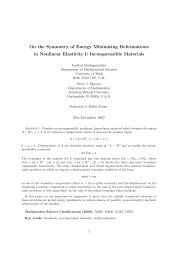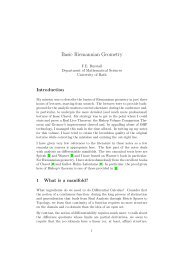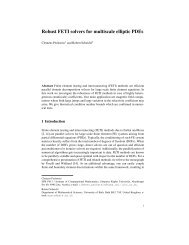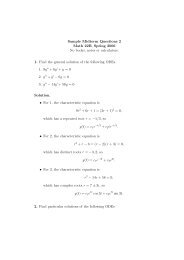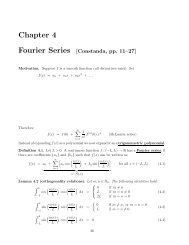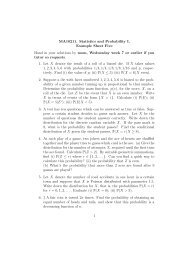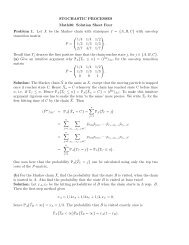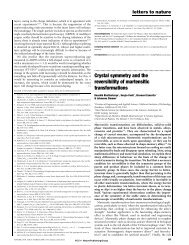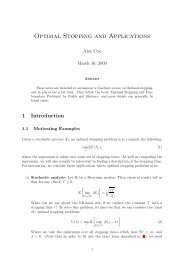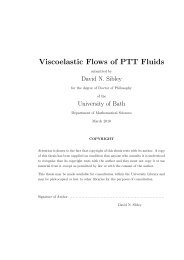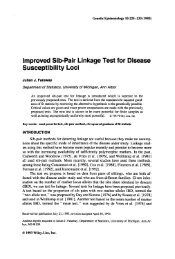1 Lévy Processes and Infinite Divisibility - Department of ...
1 Lévy Processes and Infinite Divisibility - Department of ...
1 Lévy Processes and Infinite Divisibility - Department of ...
You also want an ePaper? Increase the reach of your titles
YUMPU automatically turns print PDFs into web optimized ePapers that Google loves.
The term “<strong>Lévy</strong> process” honours the work <strong>of</strong> the French mathematicianPaul <strong>Lévy</strong> who, although not alone in his contribution, played an instrumentalroleinbringingtogetheranunderst<strong>and</strong>ing<strong>and</strong>characterisation<strong>of</strong>processeswithstationary independent increments. In earlier literature, <strong>Lévy</strong> processes can befound under a number <strong>of</strong> different names. In the 1940s, <strong>Lévy</strong> himself referred tothem as a sub-class <strong>of</strong> processus additifs (additive processes), that is processeswith independent increments. For the most part however, research literaturethrough the 1960s <strong>and</strong> 1970s refers to <strong>Lévy</strong> processes simply as processes withstationary independent increments. One sees a change in language through the1980s<strong>and</strong>bythe1990stheuse<strong>of</strong>the term“<strong>Lévy</strong>process”hadbecomest<strong>and</strong>ard.From Definition 1.1 alone it is difficult to see just how rich a class <strong>of</strong> processesthe class <strong>of</strong> <strong>Lévy</strong> processes forms. De Finetti [4] introduced the notion<strong>of</strong> an infinitely divisible distribution <strong>and</strong> showed that they have an intimaterelationship with <strong>Lévy</strong> processes. This relationship gives a reasonably good impression<strong>of</strong> how varied the class <strong>of</strong> <strong>Lévy</strong> processes really is. To this end, let usnow devote a little time to discussing infinitely divisible distributions.Definition 1.2 We say that a real-valued r<strong>and</strong>om variable Θ has an infinitelydivisible distribution if for each n = 1,2,... there exist a sequence <strong>of</strong> i.i.d. r<strong>and</strong>omvariables Θ 1,n ,...,Θ n,n such thatΘ d = Θ 1,n +···+Θ n,nwhere = d is equality in distribution. Alternatively, we could have expressed thisrelation in terms <strong>of</strong> probability laws. That is to say, the law µ <strong>of</strong> a real-valuedr<strong>and</strong>om variable is infinitely divisible if for each n = 1,2,... there exists anotherlaw µ n <strong>of</strong> a real valued r<strong>and</strong>om variable such that µ = µ ∗nn . (Here µ ∗ n denotesthe n-fold convolution <strong>of</strong> µ n ).In view <strong>of</strong> the above definition, one way to establish whether a given r<strong>and</strong>omvariable has an infinitely divisible distribution is via its characteristic exponent.Suppose that Θ has characteristic exponent Ψ(u) := −logE(e iuΘ ) for all u ∈ R.Then Θ has an infinitely divisible distribution if for all n ≥ 1 there exists acharacteristic exponent <strong>of</strong> a probability distribution, say Ψ n , such that Ψ(u) =nΨ n (u) for all u ∈ R.The full extent to which we may characteriseinfinitely divisible distributionsis described by the characteristic exponent Ψ <strong>and</strong> an expression known as the<strong>Lévy</strong>–Khintchine formula. 2Theorem 1.1 (<strong>Lévy</strong>–Khintchine formula) A probability law µ <strong>of</strong> a realvaluedr<strong>and</strong>om variable is infinitely divisible with characteristic exponent Ψ,∫e iθx µ(dx) = e −Ψ(θ) for θ ∈ R,R2 Note, although it is a trivial fact, it is always worth reminding oneself <strong>of</strong> that one worksin general with the Fourier transform <strong>of</strong> a measure as opposed to the Laplace transform onaccount <strong>of</strong> the fact that the latter may not exist.3



